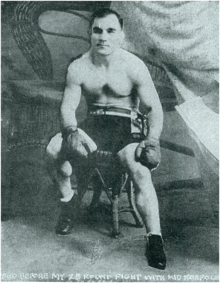Abraham Jacob Hollandersky
| Abe Hollandersky | |
|---|---|
|
Before Norfolk fight, 1914 | |
| Statistics | |
| Real name | Abraham Jacob Hollandersky |
| Nickname(s) | Abe the Newsboy |
| Rated at | Welterweight |
| Height | 5 ft 4 in (1.63 m) |
| Nationality | American |
| Born |
December 3, 1887 Berznick, Suwalk, Russia |
| Died |
November 1, 1966 (aged 78) San Diego, California |
| Stance | Orthodox |
| Boxing record | |
| Total fights | 99 |
| Wins | 25 |
| Wins by KO | 7 |
| Losses | 39 |
| Draws | 26 |
| No contests | 9 |
Abe "The Newsboy" Hollandersky (December 3, 1887 – November 1, 1966) became one of the first American boxers to win the Panamanian Heavyweight Title when he defeated Jack Ortega in nine rounds in Panama City on May 30, 1913. American congressmen, Naval personnel, and canal workers were among the crowd of nearly two thousand who watched Hollandersky gain victory over an opponent who outweighed him by over thirty pounds. The New York Times announced Hollandersky's best known win the following morning.[1][2]
Hollandersky was reputed to have fought an unprecedented 1,039 boxing matches between 1905–18, as well as 387 wrestling matches.[3][4] The record of 1039 bouts from Hollandersky's autobiography, often quoted as 1309, was featured for decades in the Guinness Book of World Records, Ripley's Believe it or Not, and hundreds of short newspaper articles made available as Associated Press fillers, appearing most frequently between 1930 and 1970.[5][6]
Several sources also credit him with taking the Welterweight Wrestling Championship of the World in December 1907. Hollandersky's claim to the Welterweight Wrestling Championship was probably a result of his defeating "Young Roeber" who wrestled frequently in New York and held several world wrestling weight division titles.[7][8][9][10][11][12][13][14]
Early life
Hollandersky was born to Jewish parents Charles and Celia Hollandersky in the small town of Berznick, in Northeastern Poland, then in the province of Suwalk, Russia. Like many Jewish families in their part of the world, the Hollanderskys struggled to survive in the grips of poverty with little opportunity to improve their fate.
Though his book and several sources, including the ship's manifest from his first entry into the United States, give his birth year as 1888, Hollandersky cited December 3, 1887 as his birth date in his passport application, and other official documents. The frequent moralizing in his autobiography was likely the result of his mother Celia's influence as she was raised by a religious leader. According to tombstones in New London and official Polish records, Celia's father was Mowza (Moses) Finkielsztejn, a "Podskolnik", in which capacity he could fill in as a Rabbi or teach Hebrew.[15] Pogroms, famine, restrictions on career opportunities, the inability to own or purchase property, and highly limited access to public secondary education caused by Tsar Alexander III's May Laws of 1882, encouraged the family to leave Russia.
Flight from Russia, arrival in America
Departing Russia as a young child, Hollandersky headed to Berlin, Germany and than Manchester, England with his mother Celia and older brother Sol. Four siblings, two boys and two girls, died of starvation prior to his departure.[16] Hollandersky's father Charles, a former tailor, had preceded him to America to find work, at some point plying his trade with his brother Falk, but becoming blind before his family reached him in America in 1899. According to genealogist Marlene Silverman, Falk Hollandersky, Abe's Uncle, emigrated to America around 1885, first living in New York, and then arriving in New London around 1892 accompanied by his wife Sarah Feyga, whom he had previously married in Berznick in 1862. By studying family tombstones, and marriage records, Silverman also concluded that Falk Hollandersky's wife Sarah and Abe's mother Celia were likely sisters, daughters of assistant Rabbi Mowza (Moses) Finkielsztejn (b.c. 1812). The two sisters in turn married the Hollandersky brothers Falk and Charles.[15][17]
According to a ship's manifest, Abe, his mother Celia, and brother Sol arrived in America in 1899. [15] An 1899 date of entry is also referenced in a letter by James Forrestal, Secretary of the Navy, dated November 15, 1946 and in an article in the Navy Times. Abe arrived in America with little or no formal schooling. He took boxing training at a local YMCA, and continued to sell newspapers as a youth, having begun by selling them in Manchester, England around the age of only eight or nine.[15][18][19]
Wrestling as a youth in New London
By the age of seventeen, Hollandersky was regularly wrestling professionally in New London, and at sixteen in September 1904 was found guilty of trespassing on the New York, New Haven, and New London Railroad. The New London judge found Abe was the "ringleader of a gang of boys who made themselves a nuisance by hanging around the station," and may have hitched the occasional ride on the boxcars.[20] For a boy who chose boxing as a profession, this was a minor offense, but Hollandersky may have suffered from a lack of adult supervision having never attended public school, and having a blind father who was limited in the role he could take in his upbringing. The following month, according to The Day, Hollandersky headed South to Louisville, Kentucky to look for wrestling matches, and may have made a visit to his Abramson relatives who had first arrived there around 1890.[21]
Life changing encounter with President Theodore Roosevelt
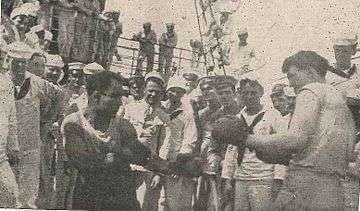

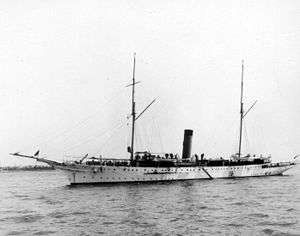
After he tried to sell a newspaper to Teddy Roosevelt aboard the presidential yacht USS Mayflower in September 1906, Roosevelt had Admiral Robley D. Evans create the official unpaid title "Newsboy of the Navy," for Hollandersky, giving him the right to sell papers to any Navy ship and travel to any destination on U. S. Naval vessels. According to Hollandersky's autobiography, their meeting took place during Roosevelt's Presidential review of the Naval fleet in New York's Oyster Bay around September 2–4, 1906, off Long Island and was a pivotal point in Hollandersky's career. Hollandersky and Roosevelt engaged in a brief and friendly exchange of light blows after Roosevelt saw Abe's cauliflower ear, and asked if he was a boxer. The President had boxed at Harvard and took a sincere interest in the eighteen year old newsboy who was keen on selling his papers to the fleet.[22]
According to historian Abraham Hoffman, Charles J. Bonaparte, Secretary of the Navy, several Secret Service bodyguards, Edith Roosevelt, the President's wife, and the well known entrepreneur Cornelius Vanderbilt were also aboard the Mayflower during Roosevelt's September fleet review. Two signed letters in Hollandersky's book authenticate a relationship between President Roosevelt and Hollandersky. These include an invitation from the President to visit him at the White House and a second letter of reference which acknowledged at least one visit took place around early 1921. Correspondence also is documented from Roosevelt's wife Edith.[23] Around 1908, while selling papers, Hollandersky claimed to have boarded one of Admiral Evans' old commands, the USS Connecticut (BB-18), flagship of the Great White Fleet, while Roosevelt was aboard.[22][24] After meeting Roosevelt, Hollandersky claimed to have boxed aboard the Mayflower to entertain members of Congress, and later to have met President Woodrow Wilson aboard the Presidential yacht Mayflower off New London.[25]
Naval acquaintances, boxing career, travels, and work with the US Navy
.jpg)
During his early work with the Navy, Abe often sold newspapers to ships off the New London harbor. While serving U. S. Naval Academy Midshipmen during their summer cruise from Annapolis in July and August in New London's Gardiner Bay, he met many future Admirals. While selling papers around 1906, he met Captain George Fried who would become famous in the late 1920s for the valiant rescues of the French ship Antinoe and the Italian freighter Florida, while captaining ocean liners of the United States Lines.[26]
.jpg)
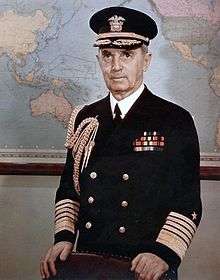
When they first met, Fried was a young fledgling sailor serving his first Naval assignment aboard the old civil war era schooner USS Hartford, where he learned the art of navigation.[27] Fried and Hollandersky maintained an acquaintance for many years. Admiral J. M. Reeves, a pioneer of Naval air warfare, was one of the many high-ranking officers who claimed to have been sold newspapers by Hollandersky very early in his career, and throughout his very distinguished years of service.
Future Commodore Henry A. Badt, was one of many Naval Academy midshipman who met Abe around 1905 in New London during the Naval Academy's summer cruise. Badt was aboard the USS Chesapeake, a three-masted, wooden-hulled, fully rigged ship, renamed the USS Severn in 1905. Abe claimed to have again sold papers aboard the Severn while she was in port near Ancon, Panama around late 1913. Badt was part of the US Naval Academy's class of 1908, according to their yearbook the Lucky Bag, during the period when Lieutenant William D. Leahy was beginning his Naval career as a teaching assistant in Physics and Electrical Engineering.[28]
Admiral Leahy, while serving as Chief of Staff to Franklin Roosevelt, would write a brief review of Abe's book in March 1930 that appeared in most editions of his books and later on December 7, 1943, sign his Award of Merit for recruiting 1700 men for the Navy in the ramp up for WWII. Leahy had formerly served as the Chief of Naval Operations from 1937–39. Also signing the award were Fleet Admiral C.W. Nimitz, largely responsible for the Navy's success at the Battle of Midway in 1942, and James Forrestal, Secretary of the Navy. Both would send photographs to Abe for his book, with Admiral Nimitz posing with Abe.[29][30]
Early boxing career and bouts with a kangaroo and bear
During his early career, Abe boxed a kangaroo in an exhibition in Australia during his first world cruise with the Navy, around 1908, and a huge muzzled bear around 1905 on 14th Street in New York City at Huber's Dime Museum, where Harry Houdini had once performed. These incidents were described with humor and detail in his book as well as much later being the subject of noted sports writer Harold Rosenthal's December 1978 article on Abe in Sports Illustrated.[31] They added a certain color to the story of his life which appealed to the newspaper reporters that wrote about him in brief biographies.
Much of his early boxing experience took place in New York City, as his family kept a residence there until at least 1910 while Abe's father maintained an apartment on 167 East Broadway.[1] As a young New York club fighter in 1906, Abe fought the better known boxers Todo Moran, Patsy Connors, Harry Greenhouse and "Buffalo" Eddie Kelly. Two years after a first round knockout of Abe, than an inexperienced nineteen year old scratching out a living in a smokey New York boxing club, Kelly would go on to challenge the legendary Abe Attell three times for the Featherweight Championship of the World.[32] On December 14, 1908, Hollandersky lost a close six round match to Maurice Lemoine at the Grand Opera House in New Haven, Connecticut. Though New London's The Day gave the decision to Lemoine, the prestigious New York Times felt Hollandersky had the better of the bout, "battering Lemoine in the sixth and last round".[33] The fight was a preliminary to a World Welterweight Championship match between reigning champion Harry Lewis, and his frequent opponent Willie Lewis. It was probably the most widely covered fight of Hollandersky's early career.
Best known New England boxing opponents
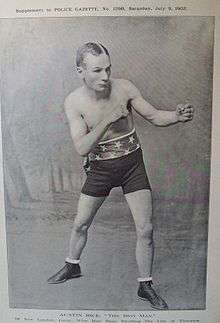
Hollandersky's best known opponents in New England included Austin Rice, Dave Palitz, Al Rogers, Italian Joe Gans, and Tommy Teague. Teague was a Navy Welterweight Champion from the USS Michigan when they fought in June 1911, and later an opponent of New York Jewish boxer Al McCoy four days before McCoy became the youngest boxer at seventeen to win the World Middleweight Championship. McCoy and Hollandersky would later both appear in 20th Century Picture's 1933 The Bowery. Fellow welterweight boxer Al Rogers had decisively beaten ex-World Welterweight Champion Honey Mellody on June 10, 1912, in Baltimore just two weeks before beating Abe in an important fifteen round bout in the same city's Empire Theatre.[34][35][36]
Frequent New London boxing opponents
Hollandersky fought fellow New Londoners Austin Rice and Dave Palitz on more than five occasions. Rice had shown enormous boxing promise at age thirty as a contender for the Featherweight Championship of the World against Young Corbett II on January 14, 1903. Hollandersky fought Rice, who was twelve years his senior, in both paid and exhibition bouts until the end of Rice's boxing career. Fellow New Londoner Mosey King, an early New England Lightweight Champion and Yale boxing coach for forty years, is included in Hollandersky's list of fights in the back of his autobiography as a "Win". King, who like Abe was of Jewish ancestry, was Connecticut's first boxing commissioner from 1921–23, and reputed to have given tips to any boxer looking to improve his game. He was a likely opponent of Hollandersky at least in a sparring or exhibition match. According to at least one source, Rice, King, and Hollandersky shared Jimmy Nelson as an early coach and sparring partner as youths in New London. Nelson had worked as a corner man for undefeated World Lightweight Champion Jack McAuliffe before coming to New London.[37][38]
Work with the Navy
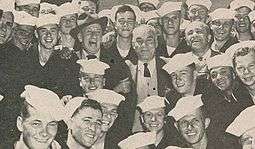
Hollandersky's long career with the Navy included work as an independent supply boat operator or "bum boater" from which he sold magazines and newspapers to the fleet. Early in his career, he saved several people from drowning and rescued stranded boats in Gardiner Bay off the docks of New London while "bum boating" for the Navy. "Bum boating" consisted of taking a small launch out to naval vessels and selling newspapers and small supplies to Navy personnel. In his small launch, he also performed tasks such as delivering mail to navy men.[39] In his mid-career with the Navy, he worked as a boxing instructor for sailors at the pier in New London near the end of WWI, and a recruiter of 1,700 naval personnel in WWII while he was living in Los Angeles. He also gave boxing exhibitions and training, and sold newspapers to Naval ships both in port, and during his two world Naval cruises. Abe helped the Navy provide relief for the aftermath of the Santa Barbara earthquake that struck on June 25, 1925. He raised War Bonds in WWII, occasionally capitalizing on his contacts with former boxers, and entertainers, such as Jimmy Durante, with whom he had worked in a movie. He later assisted the Navy in providing relief following the March 10, 1933 Los Angeles area earthquake that had an epicenter near Long Beach, California, where he had his news stand.
Three world cruises with the fleet
Hollandersky took two world cruises to Australia on Naval vessels prior to his marriage and once cruised with the fleet to Honolulu in 1925. During his cruises, and while working as a boxing instructor, he boxed bouts regularly for both the training and entertainment of the troops.
First world cruise to Australia around 1908
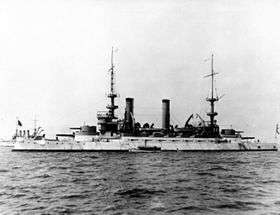
His first cruise to Australia occurred early in his boxing career, around 1907–08, and coincided with the Cruise of the Great White Fleet, a worldwide Naval cruise of sixteen battleships intended by President Theodore Roosevelt to demonstrate both strength and diplomacy. Japan was already threatening as a naval power and Roosevelt wanted to demonstrate the strength of the American fleet. Hollandersky's New England boxing record indicates that 1908 was one of the few years he would have had time for a world cruise. Abe claimed to have sailed around the world with Chief Harry Simmon Morris. Morris had served as an Ordinary Seaman and bugler on the USS Kearsarge (BB-5) in 1908 during the cruise of the Great White Fleet, and Hollandersky claimed to have sold newspapers to the Kearsarge during this period. Morris would became one of the longest serving seamen in Naval history.[40] Abe would have had time to take primarily the Australian leg of the cruise as his rigorous boxing and wrestling schedule precluded him from traveling for the full two years.[41] Hollandersky's former acquaintance, Admiral Robely Evans commanded the USS Connecticut, the flagship of the Great White Fleet, during the first part of the cruise around South America to San Diego during which Abe was busy with his boxing schedule.
Second world cruise to Australia around 1920-2
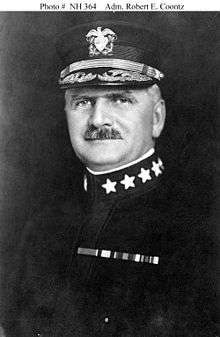
Abe took his second world cruise to Australia, sometime between 1920–22, lasting around eighteen months. He met briefly with Theodore Roosevelt, then Secretary of the Navy, prior to the cruise. In a letter of May 1921, Roosevelt thanked Hollandersky for his visit and mentioned he was aware of Abe's plans to visit the West Coast.[42] Hollandersky may have found passage aboard the USS Camden from New London to California. He boxed sailor Billy Capelle aboard the USS Camden off San Pedro, California around March 1922 and was selling papers on the Camden in the fall of 1921. Capelle, better known as Willie Cappelli or Cappelle, was an accomplished welterweight from San Pedro at the end of his boxing career. Lieutenant John "Jack" F. Kennedy, a gunnery officer on the USS Mississippi, was a frequent referee for Abe's shipboard bouts and may have refereed his bout with Capelle. Both Abe and Kennedy had worked extensively with Navy boxing teams. Kennedy, whose photograph appeared with Abe in most of his books, testified for the defense at Jack Dempsey's 1920 draft evasion trial and was considered as the referee for the World Heavyweight Championship between Jack Dempsey, and Jess Willard in Toledo, Ohio.[43][44][45]
After his second Australian cruise, Abe returned to Los Angeles in July 1922, stopped to look for wrestling bouts, and then headed to El Paso, Texas, to meet friends on August 18, before returning to Connecticut. At the intermission of a fight fought by his frequent opponent Dave Palitz in Mystic, Connecticut on August 30, 1922, Abe announced to the audience he had just returned from a world cruise.[46][47][48][49][50][51]
Third Cruise in 1925, round trip New London to Hawaii
As was often his habit before long cruises, Hollandersky visited President Calvin Coolidge in the White House in October 1924. While there, he obtained an autographed photo for his book.[52] Around January 1925, he sailed from the Northeast coast to Cuba to sell papers to the fleet and visit the Roosevelt Memorial in Santiago. He received a reference letter that February to assist him in his journey from Commander H. G. Gearing of the USS Dobbin, near Guantanamo, and then made his way to the West Coast overland by that spring making a stop in El Paso on his way to California. He would later work for Gearing at the Naval Training Center in San Diego where he continued to give occasional boxing exhibitions. Once on the West Coast, he sold newspapers to some of the 57 vessels of the combined Atlantic and Pacific fleets departing from ports in San Francisco, San Diego and San Pedro and heading for Hawaii and Australia as part of a Trans-Pacific "Good Will" cruise. The cruise was the largest assembly of Naval vessels bound for a world tour since the cruise of the Great White Fleet, in which Abe had also participated and sold newspapers. Abe received permission to sell papers to the ships of the 1925 Trans-Pacific Cruise from Admiral Robert Coontz, Commander of the cruise's flagship USS Washington.[53] Hollandersky sailed with the Cruise as far as Honolulu, Hawaii arriving around June 1925 where he claimed to have fought his last professional fight with territorial Governor Wallace Farrington attending.[54]
He then returned to San Francisco via commercial liner where he met with Mayor James Rolph who counseled him he could continue his work as a movie extra in Los Angeles should he move to the West Coast. Rolph had appeared in a few movies himself. Heading north, he helped the Navy with the aftermath of the June 29, 1925 Santa Barbara earthquake. While in Los Angeles in late 1925, he posed for a photograph with heavyweight champion Jack Dempsey and flyweight champion Fidel LaBarba while Dempsey was on a break from an exhibition match.[55] Besides appearing in Abe's books, several newspapers ran the photo under the caption, "Famous Boxing Champions Meet Again," though Hollandersky's celebrity could hardly compare to Dempsey's. Besides his Central and South American travels between 1912–1917, his two world cruises with the Navy took him to locations as afar as Japan, China, Cairo, Melbourne, Brussels, Paris, Rome and London.[56]
Boxing in Cuba, Jamaica, Panama and Chile 1912–14
Hollandersky used his naval privileges in combination with commercial vessels between 1912 and 1914, to sail south from his hometown of New London, selling newspapers to the fleet while stopping to fight boxing matches in Cuba, Jamaica, Panama, Chile, and later Mexico. In January and February 1912, taking a commercial vessel South, he fought several bouts at the base in Guantanamo, Cuba, while the fleet was on maneuvers. The New York Tribune reported "Abe has been with the fleet at Guantanamo all winter and has won several bouts with ease against the best the island affords." The Reverend W. H. "Ironsides" Reaney was a boxing mentor to Abe while he was in Cuba, and helped arrange his Cuban bouts during morning breakfasts aboard the ill-fated battleship USS Utah. Rainey helped referee a few shipboard fights, and had boxed in his earlier days. The USS Utah (BB-31) had been constructed the previous August and was on a shakedown cruise ending in Guantanamo. She would later become one of the first ships lost at Pearl Harbor.
Abe credited Reaney with helping him to find matches in Jamaica and for encouraging him to seek his fortune in Panama City. In the spring of 1912, Abe returned to the states from Cuba, resumed his boxing and wrestling career, and rescued a woman from a subway mishap that August.[57][58][59][60] Heading South the following spring, Abe defeated T. K. Wint, billed as Young Jack Johnson, "Welterweight Champion of the West Indies," and Young Joe Jeanette in ten round bouts in Kingston, Jamaica in April 1913, before heading directly to Panama and taking the Panamanian heavyweight crown from Jack Ortega.
Winning the Panamanian Heavyweight Title, May 1913
His historic first bout for the Panamanian Heavyweight Title with Californian Jack Ortega, on May 30, 1913, featured an audience of nearly two thousand and included most of the members of an American congressional party in Panama there to view the final stages of the building of the Panama Canal. Ortega was known to deliver knockout punches and was the reigning Panamanian heavyweight champion. The match ended in an eighth round foul when, by most accounts, Abe was having the better of the bout. Hollandersky was around twenty-five and in the prime of his boxing career, while Ortega was already around thirty-six, and outweighed Hollandersky by at least thirty-five pounds. According to one newspaper, after Ortega pushed him onto the ropes in the final round, "Abe was partly in the ring and partly out of it, spectators in the crowd trying to prevent his falling from the platform and Ortega, without really realizing what he was doing but fighting madly, swung low and landed on Abe's groin." The article continues, "Abe, who did not fall when the blow was delivered, walked to his corner across the ring and then laid down on the floor to recover from the effects of the punch. The injury he received was apparent to all who were close to see him when he was undressed by his seconds. It was some fifteen minutes before he was able to leave the ring." Hollandersky inferred in his autobiography the foul may have been intentional, particularly the one that ended his rematch with Ortega later in August.
That night, Hollandersky was promised a Heavyweight Championship belt at a banquet in his honor, and was invited to meet with the President of Panama, Belisario Porras Barahona.[61]
"Battling Prince" Lobo boxed a preliminary bout prior to Hollandersky's Panamanian championship bout that May. Lobo was a local Black boxer who had helped train Abe for the Panamanian championship and with whom he developed a close friendship.[2][62][63]
Rematch with Jack Ortega for Panamanian Heavyweight Title, August 1913
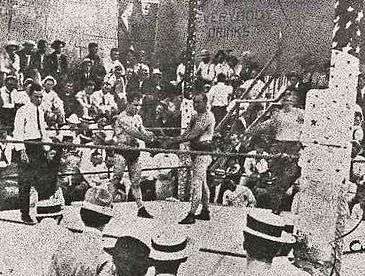
Hollandersky successfully defended his Panamanian Heavyweight Title only once, in an 18 of 45 round rematch with Jack Ortega on August 11, 1913 in the National Sports Arena in Panama City. After a morning rain, the lengthy match took place outdoors beneath the tropical sun, beginning around four in the afternoon. Hollandersky had trained for a full month, making a training camp on the neighboring Pacific island of Taboga, while Ortega had trained more diligently than he had for his first bout. The initial rounds of the match went slowly and uneventfully, followed by several rounds where Ortega clinched frequently. In the later rounds, Hollandersky landed frequent blows to the chest, probably lacking the reach to connect often with the head or chin of his taller opponent. With Ortega exhausted and struggling, the fight ended when he once again disqualified himself by hitting Abe below the belt. According to Hollandersky, in the final eighteenth round, Ortega, trying to prevent a loss by knockout, "backed away, leered at me, and then deliberately raised his leg and kicked me," though no newspaper source has been located that confirms that the blow was a kick. Ortega would be arrested in Panama City only one week later for fixing a fight by taking a first round dive against the Pittsburgh boxer Buck Crouse. Early in his his boxing career, Ortega had been convicted of assaulting an eleven-year-old girl in San Jose, California in late 1900, and was sentenced to life in San Quentin, though he served around ten years.[64][65][66][67][68]
Loss of Panamanian Heavyweight Title, January 1914
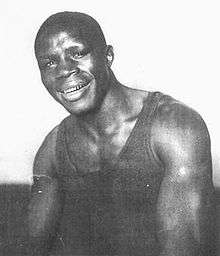
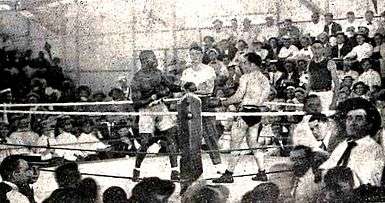
Four months later Hollandersky lost his Panamanian heavyweight title, but lasted for twenty-five grueling rounds against the young and gifted, 1921 "Colored" World Light Heavyweight Champion, William Ward, known as Kid Norfolk. Few in the crowd believed that Hollandersky would last ten rounds with the future Boxing Hall of Fame champion, who had a four-inch height advantage and outweighed him by over twenty pounds. This athletic feat seems more impressive, when considering, "from eleven until two o'clock on the day of the battle, Hollandersky was at Colon Harbor selling newspapers to the Marines on the USS Minnesota, only two hours before stepping into the ring with Kid Norfolk at four that afternoon". The match took place at a Skating Rink in Ancon, Panama, on January 18, 1914, before a sold out crowd. New London's The Day wrote that Abe had the edge in only three of the rounds, before the end when Norfolk "began battering Abe around the ring and trying hard for a knockout". The Panamanian crowd voiced their approval of the Newsboy's tenacity, and as soon as the final bell sounded to end the long contest, they "stormed the ring and carried the little fellow (Abe) off on their shoulders." Hollandersky claimed he was paid ten dollars a round for the Norfolk bout, and an additional seventeen hundred dollars that he shared from the winnings of his sailor friends, many of whom had bet on him to win. This brought his total earnings for his evening's work to $1,950 dollars, roughly two years salary for many Americans in that era.[69][70][71][72]
Boxing in Panama after loss of Panamanian Heavyweight Title
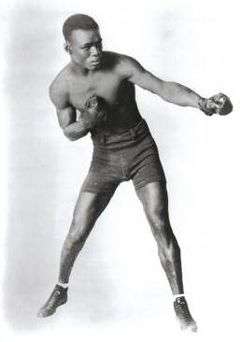
The better known opponents Hollandersky fought in Panama after his loss of the title included 1920 World Colored Middleweight Champion Panama Joe Gans, Jerry Cole, "Steamboat" Bill Scott, Tommy Connors, and Eddie Ryan. Panama Joe had such legendary speed and skill that he would act as a sparring partner to prepare Jack Dempsey for his September 1920 Heavyweight Title bout with Hall of Famer Billy Miske as well as Dempsey's earlier bout when he first took the Heavyweight Championship from Jess Willard in Toledo. [73][74] The 5' 4" welterweight Hollandersky lost to Panama Joe, the younger and stronger Panamanian Light and Middleweight champion, and the accomplished middleweight Connors of Scranton, Pennsylvania who had a five-inch height advantage. But Hollandersky gave a closer fight to the Seattle welterweight Ryan before an impressive crowd of 1500 at the Savannah Club in Ancon, Panama on February 23, 1914. The Panamanian fans voiced their disapproval of the Draw ruling by the referee as Hollandersky appeared to have landed more punches.[75] The Norwich Bulletin and even the New York Times felt Hollandersky may have had the edge in the Ryan bout which the Bulletin referred to as a "Welterweight Championship of the Isthmas." Perhaps as a result, Abe's fight records at the end of his autobiography and Nat Fleischer's 1944 Ring Record Book referred to Hollandersky as a Welterweight Champion of Panama, which he technically was not, never having received the win required to take the Welterweight Title.[76]
Mid-career, boxing, wrestling, and promoting 1914–18
Sailing South from Panama to Ecuador, and Peru, he spent the Fourth of July 1914, on a snow-covered peak in the Andes.[77] In August and September, he fought Valeriano Dinamarca and black middleweight William Daly in Valparaiso, Chile receiving a badly broken nose from a blow by Daly. Their brutal September bout, scheduled for six rounds, ended in a third-round disqualification when Abe accidentally head-butted Daly. While in Santiago, Chile, Abe fought a Jiu Jitsu wrestling match with a Count Sako, part of a Japanese wrestling troop. Abe claimed he had a cursory knowledge of certain martial arts including Jiu Jitsu. Somehow he managed to win the match, which included three sets, the first Jiu Jitsu, the second catch-as-catch-can or mixed and the third American style Greco-Roman. He lost only the first Jiu Jitsu set.
Around February 1915, Abe lost a twenty round bout to 5' 9" El Paso welterweight Frankie Fowser in Agua Prietta, Mexico, a bordertown near Douglas, Arizona. He made a brief appearance in El Paso then spent early March through early June 1915 in Fort Worth, Texas, arranging wrestling bouts, including two with Jimmy Pappas in April, winning one. He refereed a free boxing and wrestling exhibition on March 27, wrestled an exhibition with Joe Gens, a Russian Jewish immigrant, and shadow boxed at a benefit for the YMHA of Fort Worth that drew over three hundred guests.[78][79]
Difficult loss to Connecticut boxer Dave Palitz
Perhaps the single fight that most influenced the "Newsboy" to retire was his brutal loss to welterweight Dave "KO" Palitz on September 6, 1915 in Lawrence Hall in New London. During a boxing and wrestling tour in the Southwest in the first half of 1915, Hollandersky had suffered from an illness of several weeks which may have contributed to his lack of conditioning for the bout.[80] The Springfield Courier said of the twenty round battle that "K. O. Palitz of this city handed Abe the worst trimming a man ever received in a local ring, though the newsboy was on his feet at the end of the bout." New London's The Day, noticing Abe's puffy face, swollen ears, and blackened eye after the fight, wrote "he looked as if his demise were near at hand."[81][82] The following February Palitz defeated Abe again in less brutal ten round match which Hollandersky had staged and promoted. The bout included boxers Joe Azevedo, an exceptional lightweight, Young Terry, and Charley Curley. A glance at Abe's personal tally of fights at the back of his autobiography indicates he may have sparred with both Curley and Young Terry, a New Orleans born, Brooklyn based lightweight who in his career met the exceptional Jewish boxers Soldier Bartfield and Young Otto. [83] Though Hollandersky continued to find matches, and even returned to Panama for several lucrative bouts in 1916, he may have sensed his days as a competitive prize fighter fighting top talent were numbered.
Bringing Battling Levinsky to New London

On March 9, 1916, Hollandersky promoted a fight between Hall of Fame Philadelphian boxer Battling Levinsky, and Sailor Jack Carroll sponsored by the Greenwood Athletic Club, fought in Lawrence Hall in New London. Levinsky, who won the ten round bout, would take the World Light Heavyweight Championship seven months later, and hold it for four years. Like Abe, the more accomplished Levinsky, born Beryl Lebrowitz, was a prolific New York based Jewish boxer, who may have fought as many as five hundred bouts. During his career, Levinsky fought many of boxing's greatest including Jack Dempsey, Gene Tunney, Billy Miske, and French boxer George Carpentier. [84][85]
Exhibition with Featherweight Champion Abe Attell in New London
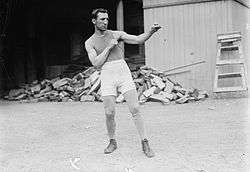
Later in New London in May 1916, Abe faced off against one of his best known sparring partners, Abe Attell, the brilliant but flawed World Featherweight Champion, suspected of betting on several of his own fights, and later accused of helping to fix the 1919 White Sox vs. Reds World Series with gangster Arnold Rothstein, an event that brought to the forefront the corruption of American sports in that era. Abe met Attell in four three round exhibition matches at Empire Theatre while Attell was giving speaking performances in New London near the end of his boxing career.[86]
Welterweight championship bout in Panama with Pat Kiley
In his last fight in Panama City in June 1917, Hollandersky lost to Pat Kiley in an unsuccessful 15 round attempt at the Panamanian Welterweight Title. It would be his last recognized championship bout. Leaving Panama in July, he would stop in New York to help accompany his father Charles, who was ill, to New London.[87][88] Perhaps as a result of this loss and his previous brutal loss to Dave Palitz in September 1915, Abe prematurely announced his retirement from boxing to his local paper on Christmas Eve 1917.[89] He continued with exhibition matches, including those on ship and on bases to assist with the training of sailors, but subsequently faced very few opponents in actual prize fights. Returning to New London in August 1917 from Panama City after his loss to Kiley, Abe was not permitted to join the Navy for WWI due to his eyesight, but was fortunate enough to find a position as a Naval boxing instructor at a base near the New London Pier. Fighting training matches for the instruction of naval troops often daily, his personal tally of fights continued to climb rapidly.[90]
Exhibition with champion Joe Walcott in New London
Facing another well known opponent in an exhibition match in November 1918, Hollandersky met the former light and welterweight world champion Joe Walcott in New London for a three round match to benefit the United War Workers of America. The bout was purely for show and Walcott was well past his prime. Appearing as the headliner for the benefit was Larry Williams, a light heavyweight still in his prime, who would act as a sparring partner for Jack Dempsey in 1921 and later for Dempsey's successor as world heavyweight champion Gene Tunney. [91] Williams would appear with Abe in MGM's "The Crowd Roars," in 1938. A photograph of Hollandersky with Williams and Gene Tunney, likely taken at a boxing benefit or training match, appear in most editions of Abe's book.[92][93]
Hollandersky's tally of fights
Nat Fleischer's Ring Record Book for 1944 listed around 450 of Hollandersky's bouts, but these were drawn from records listed in the back of Hollandersky's autobiography and are mostly unverified. They appear to contain frequent errors in the years the bouts took place and the number of rounds when compared with his BoxRec record.[87][94]
The majority of his fights were likely exhibitions staged for entertainment and training on Navy ships and bases, and included non-navy exhibitions and sparring matches. Dispute will probably continue as to the exact number of boxing matches Hollandersky fought, as his BoxRec record lists only around 100. However, these by definition exclude all his Naval and land based exhibitions, as well as sparring and training matches which he frequently included in his personal tally.
Benefits and exhibitions
A small sampling of around twenty of the benefits and exhibitions in which he boxed a few rounds include:
- George Dixon Memorial Fund at Bower's Minery Theatre, New York, January 23, 1908[95]
- Austin Rice, former World Championship Featherweight contender, exhibition for "Nest of Owls order 1382", New London CT. January 17, 1911[96]
- Young Sherman of Mystic, CT., exhibition at Elks Lodge, New London, May 24, 1911[97]
- Paddy Fenton, aging former welterweight contender, New London County Fair, six rounds, circa September 1911[98]
- Dave Palitz, 6 round exhibition, for Bartender's Local 356, Richards Grove, Groton, Connecticut, August 25, 1912[99]
- Terry Mitchell, Sparring Rounds, Abe said he had had boxed Mitchell in a letter to the Hartford Courrant dated December 3, 1912, fight may have taken place circa November 8, or December 9, 1912 when Mitchell was in New London to fight Dave Palitz. Abe had a fight with Phil Harrison in Lawrence Hall in New London on the same night Mitchell fought Dave Palitz on December 9, 1912.[100]
- USS Denver exhibition, off Panama City, boxed sailors Mussbel, Medino, Koch, and Jiran, April 5, 1914[101]
- Bill Scott, 4 round exhibition at the Variedades Theatre in Panama City, May 10, 1914.[102][103]
- Abe Attell, legendary ex-Featherweight Champ, four 3 round exhibitions, Empire Theatre, New London, May 2–3, 1916[86]
- WWI War Veterans Benefit, 3 rounds with future Connecticut State Welterweight Championship contender Dave Palitz, Chicopee, MA, December 19, 1917[104]
- Frank Ryan, 4 rounds with the Navy Welterweight Champ, in New London, May 16, 1918, State Pier[105]
- Joe Walcott, United War Workers Campaign, 4 rounds, with the former world welterweight champion, New London, November 1918[106]
- Sailor Billy Capelle of San Pedro, Lost 4-6 round exhibition aboard the USS Camden, Around late April or May 1922[107]
- Navy Flood Relief, fought sailor Mike Hector, who had boxed aboard the USS Tennessee, Long Beach Municipal Auditorium, February 3, 1937[108]
- "Night of Memories" benefit for boxing promoter Wad Wadhams, Hollywood Legion Stadium, October 9, 1937, featuring boxers Henry Armstrong, Jack Silver, Jimmy McLarnin, Jackie Fields, and more.[109]
Autobiography in 1930
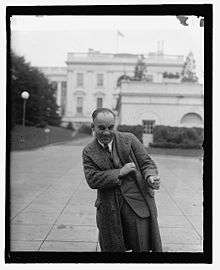
During one of Abe's few White House visits on November 8, 1929, just a few weeks after the great stock market crash, Hollandersky met briefly with President Herbert Hoover who signed a photograph for Abe's autobiography. Hollandersky may have campaigned for other signed photographs, and may have asked for book endorsements from Navy brass. Abe had probably completed his autobiography which he had written largely in New York, and was first published only four months later.[110][111][112][113]
On March 24, 1930, one of America's greatest sportswriter's, Damon Runyan, interviewed Hollandersky about his newly published book for his column "Between You and Me."[114] Around 1925, Abe had been offered a thousand dollars to finance his autobiography by his friend Bull Montana, a former wrestler and Hollywood actor, but turned him down. Montana was a friend of boxer Jack Dempsey's and not only appeared in movies with him but wrestled him in front of the press on several occasions, most notably at a well attended work out in Atlantic City, New Jersey in June 1921. A photo of Abe, posing with Dempsey, and Bull Montana appear in most editions of Abe's book.[115][116] During his interview, Runyan discussed Abe's independently financed book, and noted his frugality in completing and publishing it prior to marrying. Due to Hollandersky's very limited writing ability, his autobiography, first published in 1930, was given serious assistance by former New York columnist C. L. Edson. While in New York in 1929, Hollandersky dictated the book to Edson, and portions of the text appear to be copied verbatim from Hollandersky's dictation.[117] Hollandersky likely used newspaper articles from his vast collection of clippings as research, and may have written small portions of the text. According to Abraham Hoffman, up to 20,000 copies of his autobiography may have been printed. These included nearly annual new editions which continued until 1960. Most editions subsequent to 1930 included only new photographs, largely of Navy ships and Naval acquaintances. The second edition in 1936, added the last three chapters of the book 23-25, the only notable changes to the original text of the 1930 edition. The book's content is reliable in most respects, but occasionally Hollandersky's sequencing of events is off.[22]
_1943.jpg)
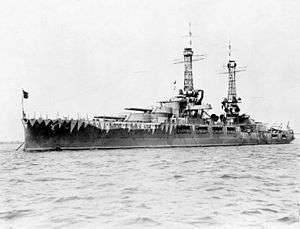
Hollandersky often took orders for his autobiography before new editions, particularly the first two, from Navy personnel of the Pacific fleet in San Pedro harbor, and for later editions in San Diego after he moved there around 1946. Three of the many ships from whose crew he took book orders were the USS Arizona, USS West Virginia, and USS Oklahoma. The Arizona and Oklahoma both had noteworthy boxing and wrestling instruction during the years Abe boarded them, and sadly both were badly damaged at Pearl Harbor, with the Arizona becoming a permanent monument after it sunk. Abe may have helped with boxing instruction and taken orders for books on the USS Tennessee and USS Nevada, as he had signed photos of several boxers from both ships in his book, and the USS New Mexico, as he posed for a photo with one of their athletic teams. Two other large battleships that Abe boarded with a Liberty Pass and known for their boxing were the USS Texas, and the USS California which was damaged at Pearl Harbor. He continued to personally sell his book directly to the public during his retirement.[118][119]
Marriage in 1931
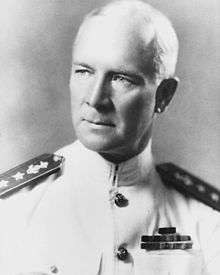

Hollandersky married Freda Weinberg on June 7, 1931 in Los Angeles, where he had moved around 1926 from New London. According to her naturalization papers, Freda, also of Jewish origin, was born in Glascow, Scotland and had emigrated to the United States from Halifax, Nova Scotia. Not long after they first met, Abe took his second Australian cruise, sometime between 1920 and 1923, lasting around eighteen months. Abe began to consider marriage with Freda after arriving from Hawaii, where he fought his last professional fight around June 1925, having taken the first leg of the 1925 Good Will Cruise.[120]
Several thousand attended his wedding reception at the Jewish Sheltering Home in Los Angeles, including a number of high-ranking naval officers, most notably Admiral Wat Tyler Cluverius, Jr., base commander of the Pacific Fleet. At the time, Cluverius was acting as Chief of Staff for Rear Admiral Jehu V. Chase, the Commander in Chief United States Fleet, who also attended the wedding. Pictures of both men at Hollandersky's wedding reception are featured in his autobiography. Cluverius, as a young Lieutenant, was one of the survivors of the sinking of the Maine, the incident which led to the Spanish–American War. On February 3, 1937, Abe attended a Navy benefit for flood relief organized under the command of Cluverius, at the Long Beach Municipal Auditorium, where he sparred with navy fighter Mike Hector in a brief exhibition. Hector, who had boxed on the USS Tennessee, had been a 1930 Navy boxing champion and an acquaintance of Abe since at least March 1936, when he signed a photo for Abe's book. Hollandersky stayed in touch with Cluverius after his retirement from the Navy and visited him in Worcester, Massachusetts in September 1947 while he was working as President of Worcester Polytechnic Institute.[121][122][123]
Work in Los Angeles and uncredited movie career after 1926
Hollandersky worked as an uncredited movie extra after his move to Los Angeles around 1926. He was often cast as a gangster or boxer. During this period he continued to sell newspapers to the fleet in Long Beach, San Pedro, and on occasion San Diego. He and later his wife Freda operated a small shop and news stand in Long Beach on 715 West Seaside Boulevard not far from the San Pedro Navy pier, where he sold newspapers and items of interest to Navy men including photographs of ships.
Movies in which he appeared include Warner Brother's 1926 lost silent film set during the Spanish–American War, Across the Pacific which featured Monte Blue and Myrna Loy. After his move to L.A., Hollandersky appeared in Fox Film's, 1928 silent film Dressed to Kill with Edumund Lowe and Mary Astor, 20th Century Picture's 1933 The Bowery, and MGM's 1938 The Crowd Roars, among others. Released on February 23, 1930, Hollandersky may have shot his few scenes for Paramount's Roadhouse Nights, when he was back in the New York area to write his book in late 1929, as the gangster film did all of their shooting in Paramount's Astoria Studios in Brooklyn.[124][125][126]

Hollandersky is shown at right with lead actor Monte Blue on the set of the 1926 version of the silent film Across the Pacific.
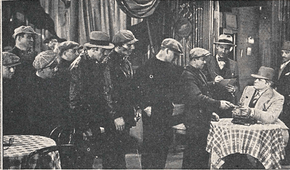
Hollandersky appeared onscreen in the gangster film about a bootleg operation, Roadhouse Nights with Fred Kohler. Actress Helen Morgan starred and Jimmy Durante made his musical debut in the scarcely remembered film. Hollandersky's right cauliflower ear is almost visible when the photo is enlarged.
In The Bowery, Hollandersky was cast with ex-Middleweight Champion Al McCoy as well as boxers "Fireman" Jim Flynn, the only man to knockout Jack Dempsey, heavyweight Frank Moran, and fellow Jewish New York boxers Phil Bloom, and Joe Glick. Hungarian born Texan Jack A. Herrick, another ex-boxer turned actor that appeared in the film, had fought in Panama City eighteen years earlier with Abe, and had faced two of the same opponents while there, the great light heavyweight Kid Norfolk, and "Steamboat" Bill Scott.[127][128]
In 1935, Hollandersky was likely cast as an extra in another movie that included gangsters, Universal Picture's She Gets Her Man. The film cast boxers Jack Perry, Phil Bloom, and Sailor Billy Vincent in uncredited roles. The lead actress Zasu Pitts, played Esmerelda, a cook in a diner who foils the plans of gangsters planning a bank robbery. Hollandersky claimed to have appeared in a movie with Zasu Pitts and had previously acted with Bloom.[129]
In MGM's The Crowd Roars, Hollandersky was given a rare brief close up after appearing in a background gymnasium scene with fellow Jewish boxers Larry Williams, Maxie Rosenbloom, Abie Bain, Phil Bloom and Joe Glick, as well as the better known Jimmy McLarnin, Jack Roper, and Tommy Herman.[130] The film was a commercial success, and starred popular actor Robert Taylor as a boxer caught up in the seamier side of boxing, who while romancing his boss's more refined daughter, comes under the influence of a crime boss. Hollandersky also claimed to have been cast in movies with world champion heavyweight boxers Max Baer and Jack Dempsey who he knew through his friends Bull Montana, and boxer Larry Williams.[131]
Retirement after WWII
After WWII, Hollandersky retired to San Diego, where he continued to sell papers. He made appearances and still gave occasional boxing exhibitions at the Naval Training Center where he worked with Captains Ralph C. Lynch Jr., and H. C. Gearing. Hollandersky received a reference from Gearing when he was selling newspapers to the fleet in Guantanamo Bay, Cuba in 1925, but first met him much earlier. His last place of residence in San Diego was 6056 Meade Avenue.[132][133]
In later life, Hollandersky continued to meet navy officers and personnel both through his sale of newspapers and at conventions and reunions of naval officers. He was made an honorary member of the American Battleship Association which met in Long Beach in 1965.[134]
He died in San Diego in early November 1966, and was buried in Greenwood Memorial Park, as was his wife Freda in 1988. He had had no children. His tombstone is headed with his ring name, Abe the Newsboy, which was used almost exclusively by the newspapers that covered his boxing and wrestling career, particularly prior to 1918.
References
- 1 2 Special Cable "Abe the Newsboy a Champion", New York Times, pg. 8, New York, 31 May 1913.
- 1 2 "Abe the Newsboy, Wins Title", Washington Herald, pg. 5, Washington, D.C., 1 June 1913.
- ↑ Hollandersky, Abe (1958). The Life Story of Abe the Newsboy, Hero of a Thousand Fights, Published by Abraham Hollandersky, Los Angeles, p. 449.
- ↑ Linthicum, Jesse, A., "Sunlight on Sports", Baltimore Sun, 13 January 1956.
- ↑ "The greatest number of fights in a career is 1309 by Abraham Hollandersky, alias Abe the Newsboy, in the fourteen years from 1905 to 1918. He filled in the time with 387 wrestling bouts (1905-16)." McWhirter, Norris and Ross (1968). Guinness Book of World Records, Sterling Publishing Company, New York, New York, p. 372.
- ↑ Ripley gave 1043 as the total number of career boxing matches in his cartoon shown in Abe's autobiography, Hollandersky, Abe (1937). The Life Story of Abe the Newsboy, Hero of a Thousand Fights, Published by Abraham Hollandersky, Los Angeles, p 439.
- ↑ Hollandersky correctly spells wrestler "Young Roeber" and claims he beat him in "Look Who's Here!, 'Tis Newsboy Abe", The Day, New London, Connecticut, pg. 14, 8 January 1909
- ↑ "Young Roeber Challenges", Brooklyn Daily Eagle, Brooklyn, New York, p. 15, 12 December 1904
- ↑ Hollandersky beat Young Rober for Welterweight Wrestling Championship, in "Abe the Newsboy Has Good Record", Washington Herald, pg 4, Washington DC, 31 March 1912.
- ↑ In December 1907, Hollandersky won the Welterweight Wrestling Championship of the world by downing Young Rober in a record four hours and eighteen minutes, in Ft. Worth Star-Telegram, pg. 10, Fort Worth, Texas, 23 March 1915.
- ↑ Roeber from Philadelphia, "Roeber Wins", The Reading Daily Times and Dispatch, Reading, PA., pg. 5, 26 March 1904
- ↑ Roeber was a bantamweight and featherweight wrestling champion, "Athletic Events", Reading Times, Reading, Pennsylvania, pg. 1, 23 April 1904
- ↑ Another source states Hollandersky was welterweight champion, "Wrestler Comes to Columbia", Scranton Republican, pg. 11, Scranton, Pennsylvania, 6 April 1911
- ↑ Abe's 4 hours, 18 minute wrestling record may have taken place at Bower's Minery Theatre, Dec. 1907, in Hollandersky, Abe (1937), The Life Story of Abe the Newsboy, Hero of a Thousand Fights, Published by Abraham Hollandersky, Los Angeles, Chapter 25, p 436.
- 1 2 3 4 Silverman, Marlene, "Hollanderskis in the Chesterfield, CT. Farming Community", Suwalk-Lomza Interest Group, Volume 23, Numbers 3-4, June, 2014, pgs. 1-11
- ↑ Hollandersky, Abe (1958). The Life Story of Abe the Newsboy, Hero of a Thousand Fights, pg. 126. Published by Abraham Hollandersky, Los Angeles.
- ↑ Falk may have been in New London as early as 1892 in "Falk Hollandersky Passes Away At Age of 94 Years," New London Day, pg. 5, New London, Connecticut, 15 October 1930
- ↑ Hollandersky, Abe (1958). The Life Story of Abe the Newsboy, Hero of a Thousand Fights, Published by Abraham Hollandersky, Los Angeles, pg. 472.
- ↑ "Navy Sponsors Testimonial Dinner", Navy Times, pg. 82, 27 October 1956.
- ↑ "Abe the Newsboy Given Warning", The Day, pg. 6, New London, Connecticut, 3 September 1904
- ↑ "Newsboy Wrestler Hies to the South", The Day, pg. 2, New London, Connecticut, 24 October 1904
- 1 2 3 Hoffman, Abe (Fall, 2007). Going a Few Rounds with Abe the Newsboy, Western States Jewish History, Volume 36, pgs 3-33.
- ↑ Letter from Roosevelt dated May 13, 1921, in Hollandersky, Abe (1937). The Life Story of Abe the Newsboy, Hero of a Thousand Fights, Published by Abraham Hollandersky, Los Angeles, Chapter 19, pg. 355
- ↑ Hollandersky, Abe (1958). The Life Story of Abe the Newsboy, Hero of a Thousand Fights, Published by Abraham Hollandersky, Los Angeles, Chapter 1, pgs. 1-2, pg. 44, (1937 edition), P. 147.
- ↑ Hollandersky, Abe (1958). The Life Story of Abe the Newsboy, Hero of a Thousand Fights, (1953) Published by Abraham Hollandersky, Los Angeles, Chapter 1, pgs. 7-32, and back of book, pg. 499.
- ↑ Abe met George Fried as a young Quartermaster aboard the USS Hartford in Hollandersky, Abe (1958). The Life Story of Abe the Newsboy, Hero of a Thousand Fights, Published by Abraham Hollandersky, Los Angeles, Preface, pg. 1.
- ↑ Fried served on the Hartford in Fried, George, "My Thirty Years at Sea", Ludington Daily News, pg. 5, Ludington, Michigan, 26 February 1929.
- ↑ Harry Badt met Abe on the "USS Severn" according to a signed photo in Hollandersky, Abe (1953). The Life Story of Abe the Newsboy, Hero of a Thousand Fights, Published by Abraham Hollandersky, Los Angeles, pg. 108
- ↑ Leahy, Nimitz, and Forrestal send signed photos to Abe in Hollandersky, Abe (1953). The Life Story of Abe the Newsboy, Hero of a Thousand Fights, Published by Abraham Hollandersky, Los Angeles, pgs. 18-21
- ↑ Copy of Certificate of Merit for recruiting in Hollandersky, Abe (1953). The Life Story of Abe the Newsboy, Hero of a Thousand Fights, Published by Abraham Hollandersky, Los Angeles, pg. 9.
- ↑ Rosenthal, Harold, "Fighter-Writer Abe the Newsboy Beat a Bear But Lost to a Kangaroo", Sports Illustrated, 11 December 1978, Volume 49, issue 24, p.112.
- ↑ "Murphey Winner Over Bert Keyes", Evening World, pg. 10, New York, New York, 26 March 1906.
- ↑ "Abe Hollandersky". BoxRec. Retrieved 7 March 2016.
- ↑ "Al Rogers". BoxRec. Retrieved 31 March 2015.
- ↑ "Abe Fights Navy Champion", Norwich Bulletin, pg. 3, New London, CT., 6 June 1911.
- ↑ "Honey Mellody". BoxRec. Retrieved 31 March 2015.
- ↑ Donahue, Thomas E., "Ins and Outs of Sport's World", The Day, pg. 23, New London, CT., 17 September 1935.
- ↑ "Sporting Notes, Boxing Gossip", Our Paper, Massachusetts Reformatory, Concord, Massachusetts, Volume 38, p.561, 19 November 1921
- ↑ Descriptions of water rescues taken from newspapers appear in Hollandersky, Abe (1958). The Life Story of Abe the Newsboy, Hero of a Thousand Fights, Published by Abraham Hollandersky, Los Angeles, Water rescues appear in early Chapter 21 and Earthquake Relief work in Chapter 23, pg. 414.
- ↑ "Chief Morris Uniform". U.S. Militaria Forum. Retrieved 3 July 2016.
- ↑ Hollandersky, Abe (1958). The Life Story of Abe the Newsboy, Hero of a Thousand Fights, Published by Abraham Hollandersky, Los Angeles, Chapter 13, p. 237, signed photo of Morris, and caption "I went around the world with him, and sold him papers in many countries."
- ↑ Letter from Roosevelt dated May 13, 1921 notes Roosevelt was aware of his plans to visit the West Coast, in Hollandersky, Abe (1937). The Life Story of Abe the Newsboy, Hero of a Thousand Fights, Published by Abraham Hollandersky, Los Angeles, Chapter 19, pg. 355
- ↑ Kennedy mentioned as Dempsey referee in Our Navy, publication of the US Navy, p. 32, Volume 15, published by US Navy, Men-O'-Warsmen, Inc., Floral Park, New York, July 1921
- ↑ Kennedy at Dempsey trial in Kahn, Roger, A Flame of Pure Fire, Harcourt, Inc., Copyright Hook Slide Inc., (1999), New York, New York, p. 164-5
- ↑ Hollandersky fought the sailor Billy Capelle aboard the USS Camden around late March 1921, Our Navy, publication of the US Navy, pps. 26 (October 1921), p. 237 (May 1922), Volume 15, published by US Navy, Men-O'-Warsmen, Inc., Floral Park, New York, October 1921 and April 1922
- ↑ Hollandersky was back in Los Angeles in July 1922, according to "Eastern Wrestler Would Meet Miller", San Francisco Chronicle, San Francisco, CA, p. 2, 23 July 1922
- ↑ "Veteran Seeks L.A. Match", Santa Cruz Evening News, pg. 2, Santa Cruz, California, 25 July 1922
- ↑ Hollandersky, Abe (1958). The Life Story of Abe the Newsboy, Hero of a Thousand Fights, Published by Abraham Hollandersky, Los Angeles, Hollandersky approximates the date of his first and second Australian cruises in Chapter 22.
- ↑ Hollandersky, Abe (1958). The Life Story of Abe the Newsboy, Hero of a Thousand Fights, Published by Abraham Hollandersky, Los Angeles, Hollandersky provides the date of one of his cruises as 1921 on the fourth page of Chapter 14
- ↑ Hollandersky announced having completed his world cruise on August 31, 1922, "Dave Palitz Wins From Russell in Twelve Round Bout in Mystic," Norwich Bulletin, Norwich, Connecticut, p.3, 31 August 1922
- ↑ Hollandersky stopped in El Paso on his way back from California and his 1922 world cruise in "Abe the Newsboy Has Had 907 Bouts", El Paso Herald, El Paso, Texas, pg. 11, 19 August 1922
- ↑ "Visits Coolidge", Lincoln Evening Journal, Lincoln, Nebraska, pg. 1, 30 October 1924
- ↑ Hollandersky, Abe (1953). The Life Story of Abe the Newsboy, Hero of a Thousand Fights, Published by Abraham Hollandersky, Los Angeles, pg. 209.
- ↑ Hollandersky took the 1925 Good Will Cruise to Hawaii in "Three Million Dollar Newsboy Will Return to Mainland Soon", Honolulu Star-Bulletin, Honolulu, Hawaii, pg. 5, 25 June 1925.
- ↑ The IP photograph appeared in several newspapers, "Famous Boxing Champions Meet Again", Indianapolis Star, Indianapolis, Indiana, p. 13, 19 December 1925
- ↑ These locations are taken from a photo signed by acquaintance, British featherweight champion Spike Robson and also in the text of his book, Hollandersky, Abe (1958). The Life Story of Abe the Newsboy, Hero of a Thousand Fights, Published by Abraham Hollandersky, Los Angeles, Chapter 22, pg. 407, also London, Paris, Rome, China and Japan in the (1936) edition, Chapter 13, pg. 249
- ↑ Reaney was a boxing mentor in "Abe the Newsboy Loses Fine Friend", The Day, New London, Connecticut, p. 12, 20 November 1915
- ↑ Subway rescue in Norwich in The Day, New London, Connecticut, 23 August 1912
- ↑ Abe left for Cuba around January 7, 1912, in "Abe the Newsboy Sails with the Fleet; Boxer and Grappler to Sell Muckrakers to Sailors", Hartford Courant, Hartford, Connecticut, 6 January 1912
- ↑ Abe definitely fought in Cuba in "Abe 'the Newsboy' Here," New York-Tribune, 21 March 1912.
- ↑ Abe met President Porras of Panama in Hollandersky, Abe (1933). The Life Story of Abe the Newsboy, Hero of a Thousand Fights, Published by Abraham Hollandersky, Los Angeles, Chapter 7, pg. 133
- ↑ Hollandersky, Abe (1958). The Life Story of Abe the Newsboy, Hero of a Thousand Fights, Published by Abraham Hollandersky, Los Angeles, end of Chapter 22, Article describing first Ortega fight and foul appears in center of page, Supplementary Picture Section, pg. 403.
- ↑ Ortega was born around 1876 and was around 37 at the time of his fight with Abe in "Jack Ortega Sentenced to Imprisonment for Life", San Francisco Call, San Francisco, California, pg 7, Saturday, 1 December 1900.
- ↑ "Boxer Abe the Newsboy here", New York Times, pg. 10, New York, New York., 3 September 1913.
- ↑ Hollandersky, Abe (1953). The Life Story of Abe the Newsboy, Hero of a Thousand Fights, Published by Abraham Hollandersky, Los Angeles, All of Chapter 17.
- ↑ Description of Ortega serving fifteen years in San Quentin in "Killing the Goose in the Canal Zone," The Winnipeg Tribune, Winnipeg, Manitoba, Canada, p. 19, 23 August 1913
- ↑ Ortega convicted of assaulting an eleven year old girl in "Jack Ortega Found Guilty", San Francisco Chronicle, San Francisco, California, pg. 4, 2 November 1900
- ↑ Ortega was sentenced to life for assault in "Jack Ortega Sentenced to Imprisonment for Life", San Francisco Call, San Francisco, California, pg 7, Saturday, 1 December 1900.
- ↑ "Abe the Newsboy loses Fight", Norwich Bulletin, pg. 3, Norwich, CT., 2 February 1914.
- ↑ "Kid Norfolk Hands Abe Fine Trimming", The Day, pg. 10, 31 January 1914.
- ↑ Hollandersky, Abe (1953). The Life Story of Abe the Newsboy, Hero of a Thousand Fights, Published by Abraham Hollandersky, Los Angeles, Description of the Norfolk fight is at beginning of Chapter 22.
- ↑ Hollandersky, Abe (1937). The Life Story of Abe the Newsboy, Hero of a Thousand Fights, Published by Abraham Hollandersky, Los Angeles, Description of the Norfolk fight is at beginning of Chapter 22, and includes a description of his earnings for the fight in picture caption.
- ↑ "Panama Joe Gans". BoxRec. Retrieved 7 March 2016.
- ↑ Panama Joe trained Dempsey for Billy Miske in"Panama Joe Gans". Cyber Boxing Zone. Retrieved 8 August 2016.
- ↑ "Abe the Newsboy Draws with Ryan", pg. 9, New York Times, New York, New York, 24 February 1914
- ↑ "Abe the Newsboy in 20 Round Bout", Norwich Bulletin, pg. 3, Norwich, CT., 11 March 1914.
- ↑ He spent fourth of July in the Andes in "Abe the Newsboy Comes Back Home", The Day, New London, Connecticut, p. 10, 14 December 1914
- ↑ "Abe the Newsboy", Fort Worth Star-Telegram, Fort Worth, Texas, (19, 23 March 1915, pg 10,) (17 May 1915, pg. 2), 21 July 1915.
- ↑ Abe fought Fowser in "Frankie Fowser", The International Horseshoer's Monthly Volume XVII, January 1916, Cincinnati, Ohio, pg. 20
- ↑ Abe had been sick in his 1915 boxing tour to the Southwest in "Abe, the Newsboy, Back from an Extended Tour", The Day, New London, Connecticut, p. 3, 24 June 1915
- ↑ "Abe the Newsboy", Springfield Courier, pg. 1, Springfield, Connecticut, 7 September 1915.
- ↑ "Palitz Inflicted an Awful Beating", The Day, pg. 12, New London, Connecticut, 7 September 1915
- ↑ Hollandersky staged the match in "Joe Azevedo to Fight Here in Abe the Newsboy's Show", The Day, New London, Connecticut, pg. 12, 26 January 1916
- ↑ "Slanting at Sportsland," The Day, pg. 12, New London, Connecticut, 29 February 1916.
- ↑ Levinsky fought an estimated five hundred fights in The Jewish Boxer's Hall of Fame, Blady, Ken, (1988) Shapolsky Publishers, Inc., New York, NY, pgs. 90
- 1 2 "The Two Abes Put on Lively Sparring Match," The Day, pg. 12, New London, CT., 3 May 1916.
- 1 2 "Abe Hollandersky". BoxRec. Retrieved 31 March 2015.
- ↑ "After Eighteen Months Spent Far Away, New London Looked Very Attractive", The Day, pg. 3, New London, CT., 14 December 1914.
- ↑ "Abe the Newsboy Has Quit Boxing", The Day, pg. 10, New London, Connecticut, 24 December 1917.
- ↑ "Abe, the Newsboy, is Not for Navy", The Day, pg. 2, New London, Connecticut, 4 August 1917
- ↑ Hollandersky fought Joe Walcott in "Fast Bouts Staged at New London", Norwich Bulletin, pg. 3, Norwich, CT, 18 November 1918.
- ↑ "Harry Greb". BoxRec. Retrieved 7 March 2016.
- ↑ Larry Williams sparred with Gene Tunney according to the article "Wildly Heralded Attractions are Billed at Weller and Liberty Today,", The Times-Recorder, Zanesville, Ohio, p. 13, 11 September 1938
- ↑ Fleischer, Nat and Andre, Sam (1944). Nat Fleischer's All Time Ring Record Book, pgs. 484-5. O'Brien Suburban Press, New York.
- ↑ Joe Gans gave a short speech, "Dixon Memorial Fund", New York Times, pg. 8, New York, NY, 23 January 1908.
- ↑ "New London 25 Years Ago", New London Day, pg 4, New London, CT., 18 January 1936
- ↑ "Elks Had Smoker", New London Day, pg. 8, New London, CT, 25 May 1911.
- ↑ "Abe, The Newsboy After Bouts", Norwich Bulletin, pg. 3, Norwich, CT, 21 July 1915.
- ↑ "Bartenders Had Pleasant Outing," The Day, pg. 5, New London, Connecticut, 26 August 1912
- ↑ Abe said he "held his own" when he met Mitchell possibly at Lawrence Hall in New London around November or December 1912 when Mitchell was there in Abe the Newsboy Writes, The Hartford Courant, Hartford, Connecticut, pg. 18, 3 December 1912
- ↑ Hollandersky, Abe (1958). The Life Story of Abe the Newsboy, Hero of a Thousand Fights, Published by Abraham Hollandersky, Los Angeles, Chap. 22, pg. 399.
- ↑ Panama Star and Herald, Panama City, Panama, Week of 10 May 1914
- ↑ As he claimed in his book, Hollandersky may have fought Scott on more than one occasion, "Bellevue Fighters Victors in Panama", The Scranton Republican, Scranton, Pennsylvania, pg. 12, Monday, 13 Apr 1914
- ↑ "Abe Wore Bright Red Suit in Bout", The Day, pg. 14, New London, CT., 21 December 1917.
- ↑ "Boxing at State Pier", pg. 3, Norwich Bulletin, Norwich, CT., 17 May 1918.
- ↑ "Fast Bouts Staged at New London", Norwich Bulletin, pg. 3, Norwich, CT, 18 November 1918.
- ↑ Our Navy, October 1921, pgs. 21, May 1922, p. 237, Volume 15, Man-O'-War Inc., Floral Park, New York
- ↑ "Navy Ring King Volunteers for Flood Relief Show", Los Angeles Times, pg. A-12, Los Angeles, CA, 3 February 1937.
- ↑ Additional boxers included Mushy Callahan, Fidel La Barba, Al McCoy, Maxie Rosenbloom, Jim Jeffries and others, "Wadham's Benefit Tonight", Los Angeles Times, pg. A-10, Los Angeles, 9 October 1937.
- ↑ Picture of Abe in front of White House dated 1929 in Hollandersky, Abe (1958). The Life Story of Abe the Newsboy, Hero of a Thousand Fights, Published by Abraham Hollandersky, Los Angeles, Chapter 12, p. 235, Chapter 19, pg. 348.
- ↑ Hollandersky, Abe (1953). The Life Story of Abe the Newsboy, Hero of a Thousand Fights, Published by Abraham Hollandersky, Los Angeles, pg. 350.
- ↑ Hollandersky met Hoover in 1929 at the White House shown in photo, Hollandersky, Abe (1953). The Life Story of Abe the Newsboy, Hero of a Thousand Fights, Published by Abraham Hollandersky, Los Angeles, pg. 81.
- ↑ Picture of Abe in front of White House dated 1929, photo of Hoover says Abe met him in the White House, pg 15 also in Hollandersky, Abe (1957). The Life Story of Abe the Newsboy, Hero of a Thousand Fights, Published by Abraham Hollandersky, Los Angeles, Chapter 5, p. 81.
- ↑ Runyan, Damon., "Abe the Newsboy Author Wants to Get Married", New York American Sports, pg. 1, New York, 24 March 1930.
- ↑ Dempsey wrestled Montana in "Dempsey Finishing Heavy Ring Work", The New York Times, New York City, page 2, 27 June 1921
- ↑ Hollandersky, Abe, The Life Story of Abe the Newsboy, (1937) Abraham Hollandersky Publisher, Los Angeles, p. 308
- ↑ "Biographical Sketch". Charles Leroy Edson Papers (coll. 27). Kansas Historical Society. Retrieved 4 August 2015.
- ↑ Hollandersky, Abe, The Life Story of Abe the Newsboy, (1953) Abraham Hollandersky Publisher, Los Angeles, Photos usually appearing in Chapter 11, p. 211
- ↑ Hollandersky, Abe, The Life Story of Abe the Newsboy, (1953) Abraham Hollandersky Publisher, Los Angeles, Chapter 20, p. 359, appearing in some earlier versions in Chapter 19.
- ↑ Hollandersky, Abe (1937). The Life Story of Abe the Newsboy, Hero of a Thousand Fights, Published by Abraham Hollandersky, Los Angeles, Approximate years of Second Australian cruise appear in Chapter 23.
- ↑ Fontaine, J. Victor, "Admirals and Even President's Abe's Customers for over Fifty Years," Worcester Sunday Telegram, 21 September 1947, p. 18
- ↑ Cluveris attended Abe's wedding in Hollandersky, Abe (1953). The Life Story of Abe the Newsboy, Hero of a Thousand Fights, Published by Abraham Hollandersky, Los Angeles, Chapter 20, pg. 361.
- ↑ Freda Wineberg's Naturalization Application, May 8, 1936, available on Ancestry.com
- ↑ "Roadhouse Nights (1930) IMDB". IMDB. Retrieved 7 March 2016.
- ↑ "Across the Pacific (1926) IMDB". IMDB. Retrieved 7 March 2016.
- ↑ "The Bowery (1933) IMDB". IMDB. Retrieved 7 March 2016.
- ↑ Frank G. Menke, "Bettors Against English Polo Team Take Long Chance," El Paso Herald, June 6, 1914.
- ↑ "Jack Herrick". BoxRec. Retrieved 3 April 2016.
- ↑ "TCM Full Cast of She Gets Her Man". TCM. Retrieved 28 April 2015.
- ↑ "Pretty Boy to HeMan", Dallas Morning News, pg. 12, Dallas, TX., 9 August 1938.
- ↑ He acted with Dempsey and Baer according to Hollandersky, Abe (1958). The Life Story of Abe the Newsboy, Hero of a Thousand Fights, Published by Abraham Hollandersky, Los Angeles, pgs. 327, 411.
- ↑ Hollandersky, Abe (1958). The Life Story of Abe the Newsboy, Hero of a Thousand Fights, Published by Abraham Hollandersky, Los Angeles, pg. 453.
- ↑ Late life interview with Abe in, Clutter, Mark, "Navy Newsboy Began By Taking Poke at President," Long Beach Independent, page 11, Long Beach, California, 15 June 1965
- ↑ "Battleship Navy Sailor's Convention in Long Beach", Independent Press Telegram, Long Beach, California, pg. 42, 1 August 1965
Further reading
- Blady, Ken, The Jewish Boxers' Hall of Fame, (1988). Shapolsky Publishers, Inc, New York, ISBN 0-933503-87-3, pp. 71–76.
- Hollandersky, Abe, The Life Story of Abe the Newsboy, Hero of a Thousand Fights with U. S. Navy, (1958). Published by Abraham Hollandersky, Los Angeles.
- Hoffman, Abe (Fall, 2007). "Going a Few Rounds with Abe the Newsboy", Western States Jewish History, Volume 36, pgs 3-33.
External links
- Professional boxing record for Abraham Jacob Hollandersky from BoxRec
- Professional boxing record for Jack Ortega from Boxrec
- www.findagrave.com
- www.jewishgen.org/SuwalkLomza
